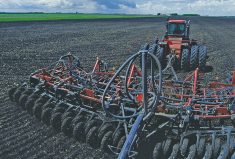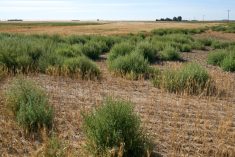To seed early or not to seed early; that is the question.
“If you have an early spring, there is that tendency to want to go early,” said Doon Pauly, agronomy research scientist with Alberta Agriculture and Rural Development in Lethbridge.
“I’m fully expecting that we will be in the field by the middle of April.”
Soil temperature and the risk of frost are the top-of-mind factors, but there are other factors to consider, say the experts.
Pest problems
For example, peas can go into cold ground, but cereals can be plagued by saprophytic organisms that will eat the seed. Saprophytic bacteria eat dead organic material and become more active in wet, cool temperatures (typically 1 C or 2 C).
“If you don’t treat your seed, there will be saprophytic bacteria that will rot that seed so it won’t germinate,” said provincial crop specialist Harry Brook.
Even when things seem to go well, there can be problems. Sure the neighbours will be a bit envious if your canola fields are the first to emerge in your area. But when that canola blooms, it will be cabbage seedpod weevils that take notice.
“If your canola is the first in the area, you know without a shadow of a doubt that you’re going to have to spray for them,” said Brook.
Read Also

Hail research hopes to benefit potato growers
Alberta research scientist measures hail storm and heat dome affects on potato crops
Early birds
Of course, as Pauly puts it, “the warmer the soils are, the faster that seed will pop out of the ground.”
But don’t expect a big head start in spring to last right through to fall.
“A day in April isn’t necessarily the same as a day in May,” said Pauly. “Three to five days earlier in April might only get you a day or two further in advance (by harvest). It’s not day per day, because we’re talking about seeding into cooler conditions. The heat accumulation benefit is not the same as during warmer parts of the year.”
Seeding early can also present staging and timing challenges. For example, an early-seeded crop may emerge just as wild oats are becoming an issue. If the crop is peas, your herbicide options are limited (Odyssey or a similar product) and they’re not only expensive but have to be applied early. Wild oats control can also get tricky with early-seeded cereals, although there are products that offer good control over a range of staging.
The advantages
There are several and the big one is higher yield. A 2006-09 study led by renowned agronomy research scientist Ross McKenzie found early-seeded cereals had increased tillering while oilseeds got yield bump because of increased pod formation.
There are also less obvious benefits.
When exposed to chilly overnight temperatures (even as low as -3 C), canola maintains frost tolerance and will later be able to withstand light frosts that would kill canola that emerged when overnight temperatures were higher. And seeding canola early can help the crops avoid overly warm heat during the flowering stage.
And, of course, starting early means more time to get the crop in.
“With the size of farms increasing, and limited labour, a lot of producers are really under a time pressure to get all the crops seeded on all the land they have,” noted Brook.
Feeling lucky?
Before pulling the trigger, Brook recommends producers check out the frost dates on Alberta Agriculture’s website (search for ‘freezing date’).
The website lists the average date of the last spring frost (and first one in autumn) for 114 locations.The earliest date is May 8 (for Duchess) and there are plenty of dates in late May stretching all the way to June 12 (Newbrook).
Reviewing those dates may curb your enthusiasm, but the bottom line is that the earlier you seed, the greater the risk.
“Producers are tempted to push the envelope and some days they will get away with it when other days they won’t,” said Brook. “You can seed earlier than normal, but there is a chance that you can run a real risk if the frost kills it all out.”
And it can be a lot worse than that, said Pauly, recalling one year when winter returned with a vengeance in the middle of April.
“It was -25 C. There were crops that were already seeded and up when they got a week of really awful weather.”

















